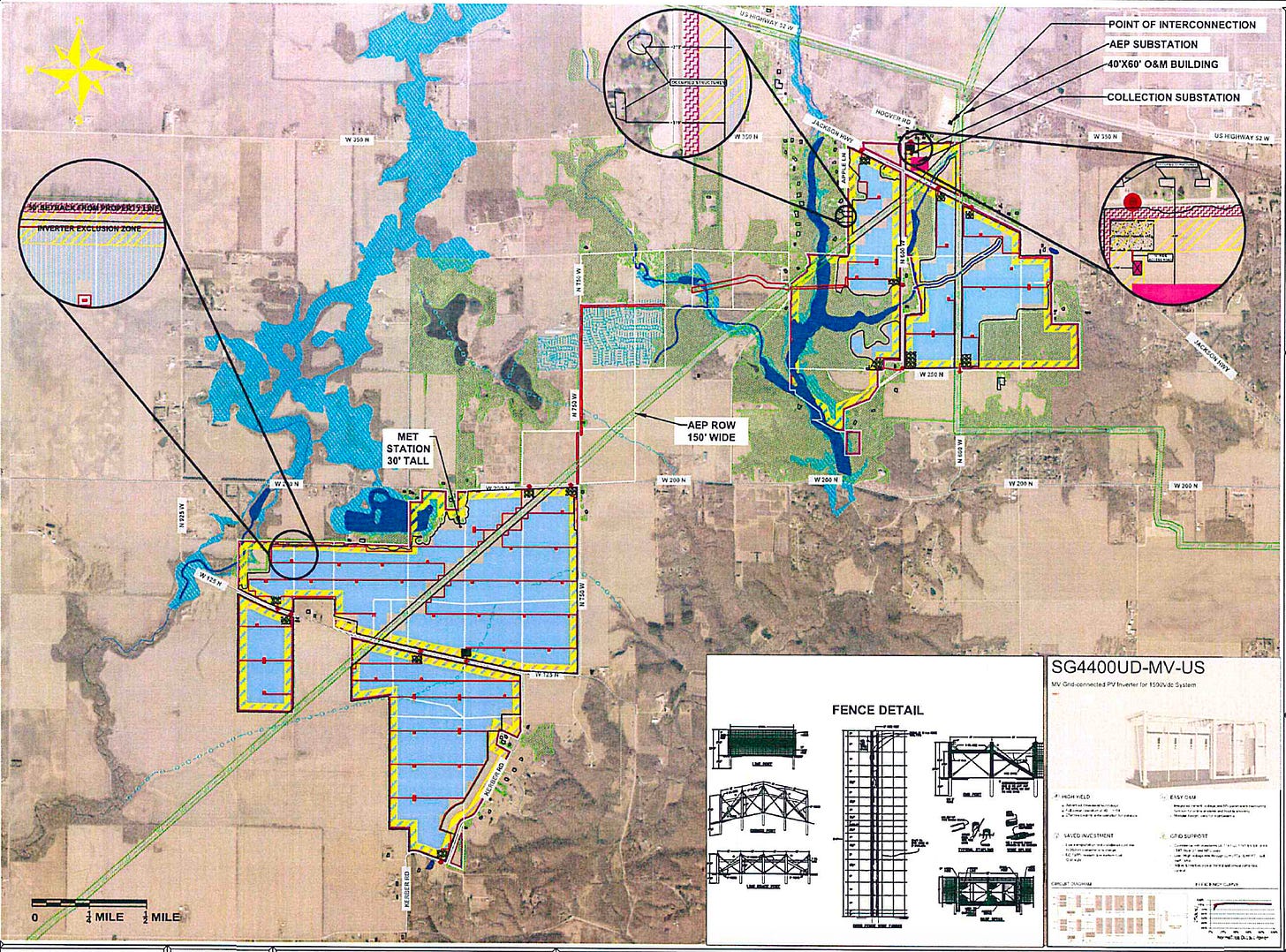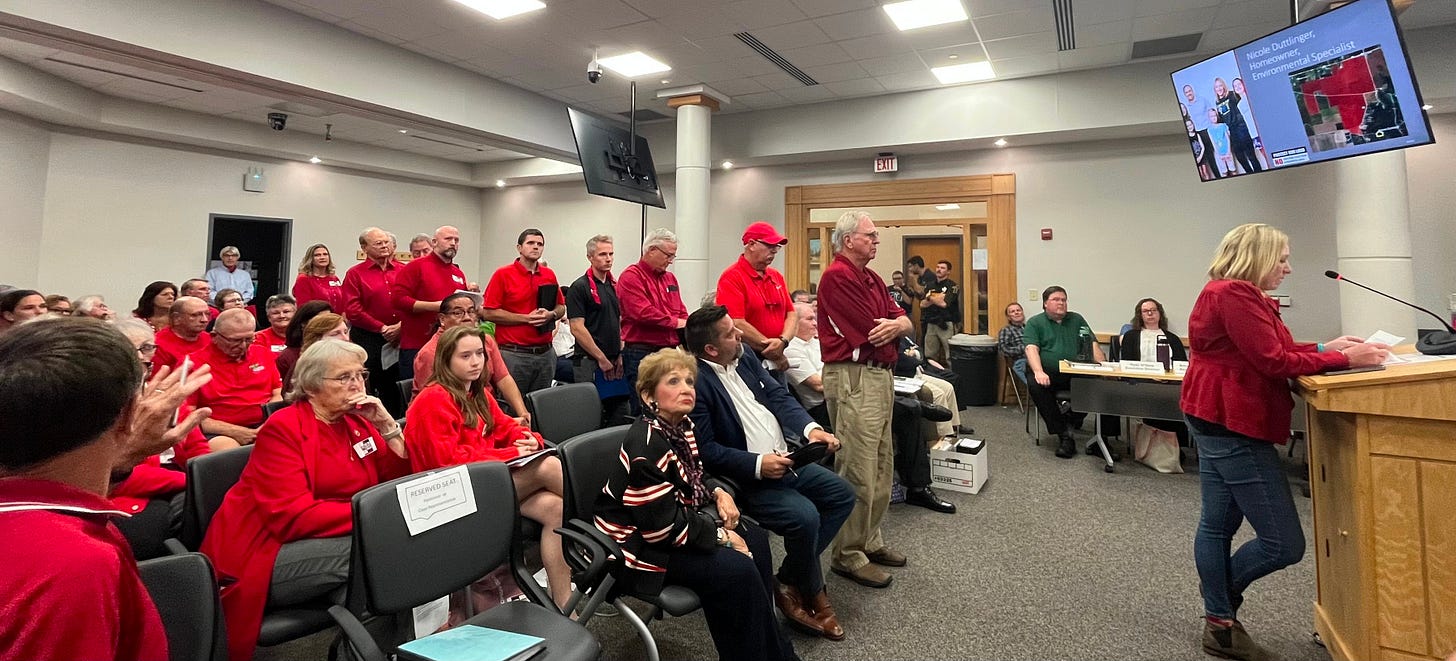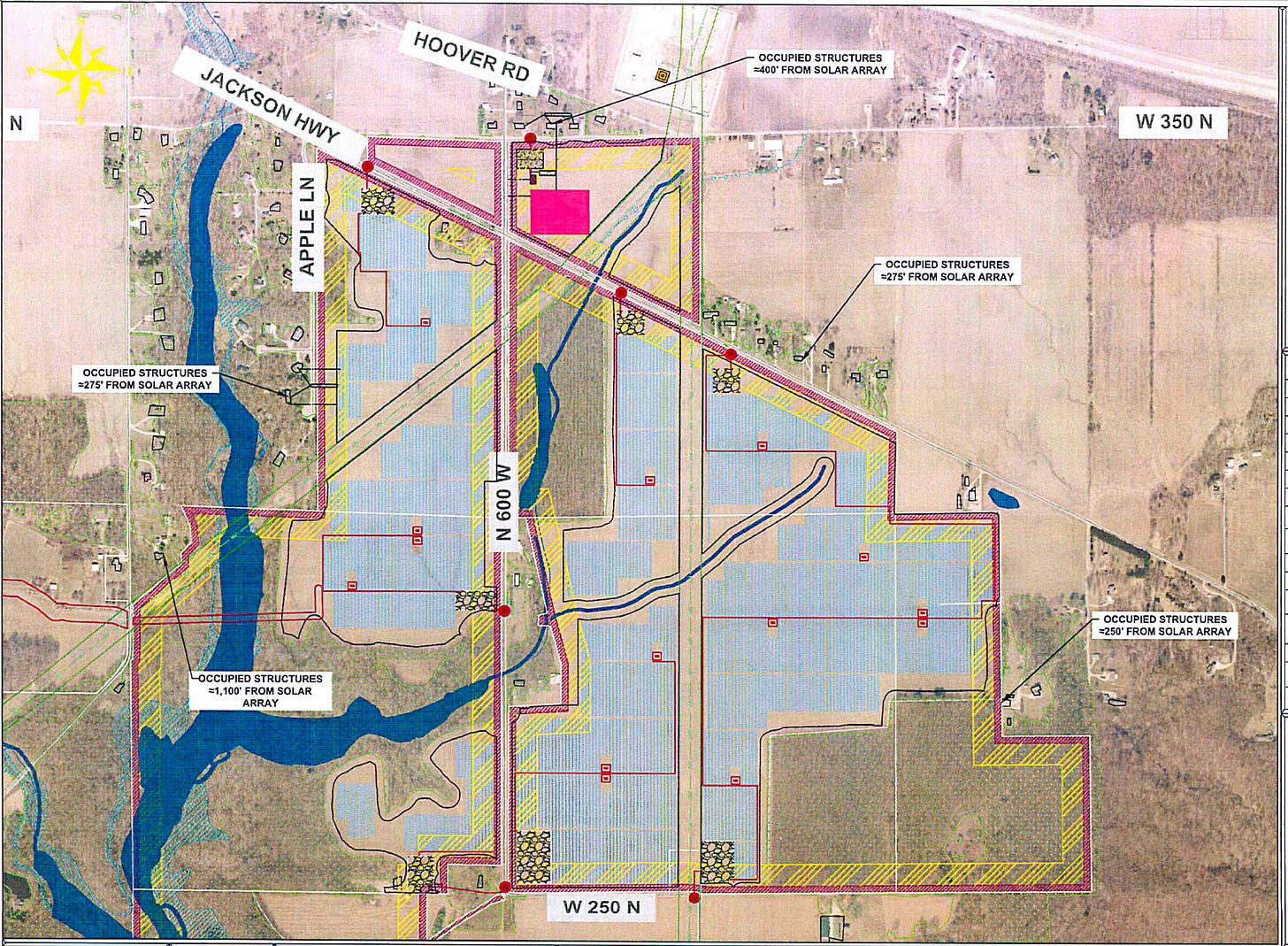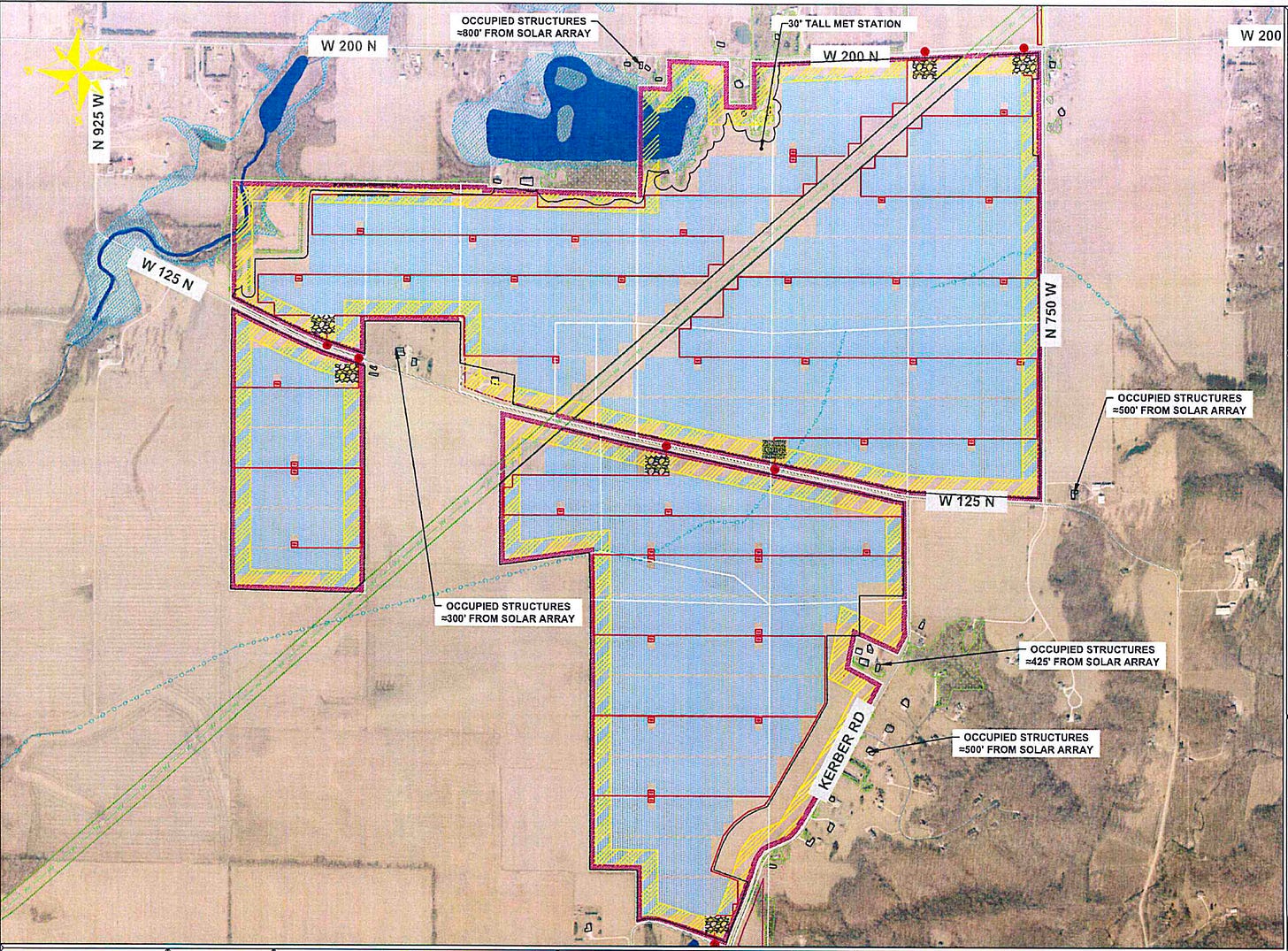1,700-acre Rainbow Trout Solar project denied after marathon hearing
Neighbors celebrate, company looks to regroup as Board of Zoning Appeals votes 4-3 against what would have been Tippecanoe County's first utility-scale solar project
What would be Tippecanoe County’s first utility-scale solar project lost its bid for a special zoning exception needed for construction by the slimmest margin, after a marathon and often pointed hearing Wednesday before the Area Board of Zoning Appeals.
The seven-member BZA voted 4-3 against a special exception for the $160 million Rainbow Trout Solar Project, a 1,700-acre, 120-megawatt array proposed by a pair of companies, Geenex and RWE Clean Energy, spreading panels across miles of ground near Montmorenci, seven miles west of West Lafayette.
The vote came at 1:23 a.m., greeted with cheers from neighbors, after more than 5½ hours of testimony from an overflow crowd that spilled into the first floor hallways of the County Office Building in downtown Lafayette.
The vote effectively put the skids on the project for at least a year, given a moratorium Tippecanoe County commissioners passed in June to rethink the adequacy of a large-scale solar ordinance put into county zoning codes just four years ago.
“We're certainly disappointed with the decision tonight, but we really appreciate all the time that was spent here discussing a project that could be this impactful to Tippecanoe County,” Nick Gruzdowich, director of utility scale development for RWE Clean Energy, said after the vote.
“At this point, we’re going to analyze everything that happened here tonight and explore all our paths forward and do what’s in the best interest of the project,” Gruzdowich said. “We intend to continue pushing forward.”
Speakers – many dressed in red representing opposition to the project or teal for those pressing for it – didn’t disagree so much about the merits of solar energy.
Instead it came down to whether the project touted to be capable of powering 20,000 homes was in the right spot and whether Geenex and RWE Energy’s plan was specific enough to meet county zoning ordinances created in 2021 – ones already under review, according to a one-year large-scale solar moratorium county commissioners passed weeks after the Rainbow Trout application for a special exception was filed in May.
Neighbors organized against the project, along with their Fort Wayne-based attorney Justin Kuchmay, argued that Geenex and RWE Clean Energy were putting home values, drainage and prime farmland at risk on a proposal that didn’t come with adequate and required specifics about where the energy would go, was still playing with setback distances from residences and basically was rushed to beat a county review of guardrails for utility-scale solar. They argued that Rainbow Trout likely was just the first of what could be more industrial solar project and urged the BZA members to pause to make sure it was done correctly. Kuchmay hinted that a BZA vote in favor of Rainbow Trout Solar would wind up in court.
Tracy Brown, a Tippecanoe County commissioner, joined more than three dozen people speaking in opposition, urging BZA members to deny the request and give the county time to study its solar ordinance.
“The moratorium is just an opportunity to pump the brakes, look at that original ordinance and see what we missed – and there could be a lot that we missed,” Brown told BZA members. “If the folks proposing the project wanted to take it off the table right now, I'd be OK with that. I know they're not going to do that. You're going to have to make a decision. And I ask on behalf of board of commissioners, that decision be to not grant the special exception.”
Nearly as many people spoke in favor of Rainbow Trout, saying it was an important piece of renewable energy.
The companies argued that they’d been working on the project since 2020 and had been trying to address concerns from neighbors since filing for the special exception in May. In early August, the companies unveiled a plan that would make the solar panel footprint more compact, after residents raised issues about how close they would be to their homes. Solar energy proponents argued that the opposition to Rainbow Trout amounted to neighbors not wanting to look at the panels instead of rows of corn or beans.
Ballots from the seven BZA members showing how they voted and why weren’t immediately available early Thursday morning.
“We really felt like we had some very black-and-white issues where the current ordinance speaks clearly, and we tried to lay those out tonight to show where this project did not meet those,” Kenny McCleary, who helped lead the neighbors’ pushback, said. “We’re just very thankful that the BZA was patient tonight in listening to way we had to say. … As we’ve been saying all along, this is a bad project in a bad location.”
Wednesday’s hearing wasn’t going to be the last for the Rainbow Trout proposal, whether the BZA sided with it or not.
The project still would have needed a line of other regulatory approvals, including from the Indiana Department of Transportation, the county building commissioner and the county’s surveyor on drainage.

About the project and the request: Geenex – a North Carolina-based company that initiated the project in 2021 – and RWE Clean Energy – a company with U.S. operations based in Austin, Texas and that bought the Rainbow Trout project in early 2025 – filed for the special exception in May for a 120-megawatt project that covers miles of land from just north of Division Road to Jackson Highway in Montmorenci.
According to the application, property leases for the solar project would cover 1,700 acres, coming from six property owners. Of that, 1,051 acres are considered buildable and are anticipated to be used for the solar array and associated infrastructure, according to the application. The rest of the land will be used for required setbacks, buffers and environmental preservation, according to the application. Construction would start in 2026, with commercial operation starting in 2027, according to the application, with the project lasting up to 40 years.
The project would include more than 270,000 individual solar panels. Those would be mounted on tracking systems that are about 180 feet long and can support 45 solar modules. Underground cables would lead to one of an estimated 53 inverters, which take direct current electricity generated by solar panels and convert it to alternating current electricity, which the electrical grid uses.
Look for more on this story coming later today.
Thank you for supporting Based in Lafayette, an independent, local reporting project. Free and full-ride subscription options are ready for you here.
Tips, story ideas? I’m at davebangert1@gmail.com.





Wonder what Hoosiers have against lower utility bills?
Hopefully the landowners can find other great projects to turn their land over to. High density subdivisions, hog fans, etc.
Realistically, this was the first project targeting these sites. And it won’t be the last. The next project will likely be permanent changes to the land and that could never be returned to farm. It’s unfortunate the nearby residents didn’t consider the long term ramifications of a denial could mean.